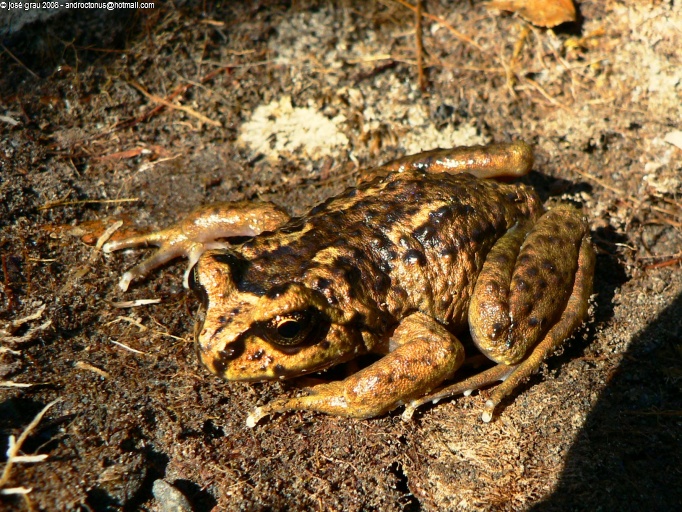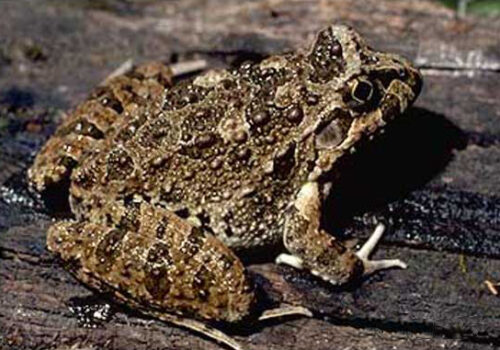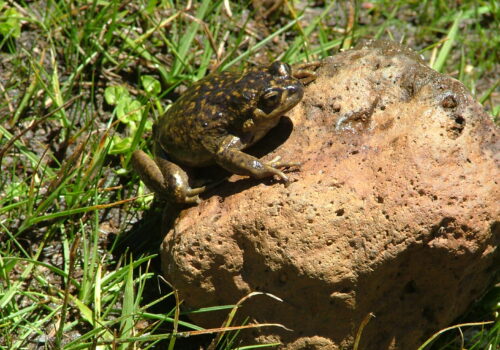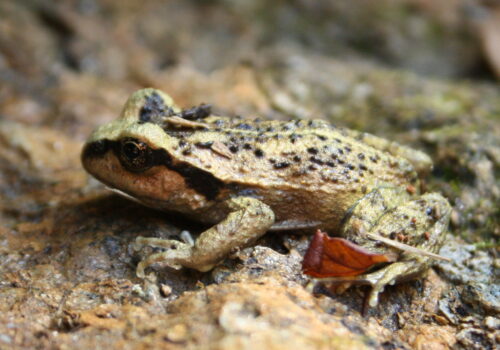- Exploring Alsodes verrucosus: The Enigmatic Amphibian of the Andean Forests
- Taxonomy and Classification of Alsodes verrucosus
- The Mysterious Habitat of Alsodes verrucosus
- Distinctive Physical Features and Adaptations
- Behavior and Life Cycle: A Quiet Life in the Shadows
- An Essential Link in the Ecological Chain
- Confronting Threats and the Urgency of Conservation
- Cultural Reverence and Scientific Discoveries
- A Call to Conservation: Preserving the Magic of Alsodes verrucosus
Exploring Alsodes verrucosus: The Enigmatic Amphibian of the Andean Forests#
In the damp, shadowy realm of southern Chile’s temperate forests, a unique amphibian quietly makes its home—the intriguingly elusive Alsodes verrucosus. Known more colloquially as the “warty spiny-chest frog,” this remarkable species plays an essential role in the delicate ecological tapestry of this vibrant region. Hidden away in moss-covered rocks, beneath lush foliage, or near the crystal-clear mountain streams of its habitat, Alsodes verrucosus thrives in secrecy, unveiling its mysteries only to the most patient and observant eyes.
Scientifically classified as Alsodes verrucosus, this amphibian species showcases not only fascinating biological adaptations but also embodies the rich biodiversity of Chile’s temperate forests. One particularly captivating quality about this frog is its cryptic coloration and detailed warty skin texture, which allows the animal to blend seamlessly into its surroundings—a true master of disguise.
But beyond its inconspicuous lifestyle, Alsodes verrucosus symbolizes an ecosystem’s health and stability. Amphibians, in general, are known bioindicators, sensitive to environmental changes and water quality fluctuations. The mere presence or absence of this specific frog species serves as an ecological gauge—a delicate warning bell for conservationists, policymakers, and the community at large.
Taxonomy and Classification of Alsodes verrucosus#
The scientific study of Alsodes verrucosus unveils it as part of a diverse family known as Alsodidae, widely distributed in temperate southern South America. Within this family, the genus Alsodes comprises multiple species, each uniquely adapted to survive the often-challenging conditions found in the Andean region and the Patagonian wilderness.
Named in the 19th century by researchers intrigued by its distinctive skin texture—”verrucosus” meaning “covered in warts”—this amphibian’s Latin moniker elegantly encapsulates its appearance. Closely related species within its genus share morphological similarities, yet Alsodes verrucosus stands unique in nuanced adaptations specific to its habitats, forging links with surrounding flora and fauna and illustrating fascinating ecological dynamics.
The Mysterious Habitat of Alsodes verrucosus#
Alsodes verrucosus calls the mist-laden temperate forests of southern Chile home. Specifically, this amphibian is predominantly observed within the regions encompassing the Andes mountains, extending through temperate rainforest ecosystems and pristine montane streams.
A Realm of Mosses and Moisture#
Navigating these dense forests, one is immediately enveloped by lush greenery, thick carpets of moss, ferns cascading from twisted branches, and a perpetual mist that clings gently to the skin. This moisture-dense environment provides the ideal landscape for Alsodes verrucosus to thrive. Here, hidden beneath damp logs, rocks, and tangled roots near small streams, it finds optimal humidity and ample shelter from predators and harsh elements.
Stream banks are particularly favored locales; the pristine, oxygen-rich waters serve as crucial breeding grounds where eggs and tadpoles prosper before metamorphosing into terrestrial adults. The amphibian’s survival depends wholeheartedly upon this delicately balanced habitat— any disruption could cripple Alsodes verrucosus populations.
Distinctive Physical Features and Adaptations#
Among nature’s infinite variety of frogs, Alsodes verrucosus exhibits a truly distinctive presence. Adult individuals typically measure between 40 to 65 millimeters in length, robust and sturdy in appearance, perfectly suited to their rugged forest lifestyle. Their bodies reveal an impressive display of camouflage—shades and hues often indistinguishable from their surroundings, varied intricately between brownish, olive, gray, and subtle patches and splotches that mimic moist earth, fallen leaves, and tree bark remarkably well.
The exceptional texture of their skin, peppered with pronounced wart-like bumps and raised spots, provides further concealment. These rough textures mimic moss and lichen growth, making detection incredibly challenging for predators and naturalists alike. Beyond cosmetic advantage, this rough skin texture enhances moisture retention, pivotal for amphibians residing within marginally fluctuating climates of the southern Andes.
Interestingly, males possess keratinous spiny projections on their chests and fingers, primarily during breeding season. The precise function remains of considerable interest; however, scientists theorize that these projections assist in clasping females securely during amplexus, the mating embrace characteristic among frogs.
Behavior and Life Cycle: A Quiet Life in the Shadows#
Life for Alsodes verrucosus emerges subtly, hidden from view as tadpoles quietly develop in clear stream beds, slowly metamorphosing into juvenile frogs throughout Chile’s warmer summer months. This tadpole developmental stage relies strongly upon pristine, cold, freshwater streams. Juveniles eventually migrate onto adjacent terrestrial habitats, maturing into adults perfectly adapted to concealment and survival beneath dense vegetation.
Feeding Strategies and Secluded Behavior#
Primarily nocturnal and cryptic by nature, adult Alsodes verrucosus emerge at nightfall to forage discreetly on insects, larvae, spiders, and other small invertebrates. Their slow, deliberate movements often belie the agility necessary to snatch unsuspecting prey with surprising precision. Such quiet maneuvering positions them as efficient hunters despite their deceptively relaxed demeanor.
Breeding Rituals Under Moonlit Canopies#
When breeding season descends, typically from late austral spring through early summer, Alsodes verrucosus engages in subdued yet fascinating courtship behaviors. Males gently vocalize from rolling stream edges, emitting quiet, rasping calls that blend seamlessly with ambient forest sounds. Once mutual selection occurs, females deposit gelatinous egg clusters upon carefully chosen submerged vegetation and rocky stream bottoms, where embryos thrive safely amidst flowing waters.
An Essential Link in the Ecological Chain#
Alsodes verrucosus occupies a vital niche within its ecosystem, acting simultaneously as predator, prey, and sentinel species. By controlling insect populations through predation, it influences local biodiversity, maintaining ecological balance. Concurrently, it serves as prey for a suite of predators, including snakes, birds, and small mammals, thus supporting higher trophic level organisms and maintaining ecological continuity.
The heath of Alsodes verrucosus populations directly reflects aquatic ecosystem conditions, making the species exceptionally valuable to ecologists and conservationists who monitor environmental shifts and potential threats impacting biodiversity health.
Confronting Threats and the Urgency of Conservation#
Unfortunately, Alsodes verrucosus encounters escalating threats significantly impacting its populations. Habitat degradation stemming from deforestation, alteration of streams for hydroelectric development, agricultural encroachment, and climate change constitute meaningful disturbances in the carefully balanced habitats critical for survival. Increasingly unpredictable weather patterns—particularly intensified drought events—pose additional stressors, forcing populations into fragmented areas and reducing genetic diversity and resilience.
Current Conservation Efforts#
As a response to observed declines, local and international conservation organizations collaborate towards strategies aimed at mitigating threats facing Alsodes verrucosus. Efforts include habitat protection initiatives, sustainable management of local ecosystems, prudent water resource management, and increased monitoring programs aimed at early detection of population changes.
Cultural Reverence and Scientific Discoveries#
Though primarily little-known culturally outside scientific circles, indigenous communities historically inhabiting the southern Chilean region have maintained deep respect toward local amphibian wildlife, symbolically linking their presence to water purity and ecozone health. Scientifically, Alsodes verrucosus remains a cornerstone in understanding bioindicators in mountainous freshwater ecosystems, morphologically unique adaptations, and responses to rapidly shifting climate scenarios.
A Call to Conservation: Preserving the Magic of Alsodes verrucosus#
The quiet, remarkable existence of Alsodes verrucosus illuminates how fragile yet interconnected our environmental world remains. Ensuring the future survival of this extraordinary frog directly translates into safeguarding the myriad other species—flora and fauna alike—that depend upon it. Conservation transcends being merely altruistic; protecting Alsodes verrucosus symbolizes preserving entire landscapes, rivers, and forests, collectively vital stabilizers of global biodiversity and ecological resilience.
We all share the responsibility to sustain these intimate relationships with our planet’s treasures. By raising awareness, supporting science-based conservation, and demanding conscientious environmental stewardship, collectively we can ensure Alsodes verrucosus thrives alongside us for generations yet unseen, keeping alive the tapestry of life that defines our world’s natural wonders.















